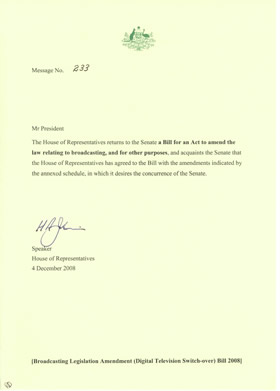126 House of Representatives amendments on bills originated in the Senate
-
When a bill has been returned from the House of Representatives with amendments, the message and the amendments shall be printed and a time fixed for taking them into consideration in a committee of the whole.
-
Amendments made by the House of Representatives may be agreed to with or without amendment, or disagreed to, or the consideration of them postponed, or the bill ordered to be laid aside.
-
An amendment shall not be proposed to an amendment of the House of Representatives that is not relevant to it, and an amendment may not be moved to the bill unless it is relevant to, or consequent upon, the acceptance, amendment or rejection of a House of Representatives amendment.
-
When amendments made by the House of Representatives have been agreed to by the Senate without amendments, a message shall be sent informing the House of Representatives accordingly.
-
If House of Representatives amendments have been agreed to with amendments, the bill shall be returned with a schedule of those amendments, in a message requesting the concurrence of the House of Representatives.
-
If House of Representatives amendments have been disagreed to, the bill may be laid aside, or it may be again sent to the House of Representatives, with a message requesting its reconsideration.
-
When a bill is returned to the House of Representatives with amendments made by the House of Representatives disagreed to, the message containing the bill shall also contain reasons for the Senate not agreeing to the amendments proposed by the House of Representatives.
-
The reasons shall be drawn up by a committee appointed for that purpose when the Senate adopts the report of the committee of the whole disagreeing to the amendments, or may be adopted by motion at that time.
-
When amendments have been made by the Senate on the amendments of the House of Representatives, a schedule of those amendments shall be prepared, shall be certified by the Clerk, and shall accompany the bill.
Amendment history
Adopted: 19 August 1903 as SOs 216, 217, 218 (corresponding to paragraphs (1) to (3)), 219 (paragraphs (4) to (6)), 220 (paragraphs (7) and (8)) and 221 (paragraph (9)) but renumbered as SOs 222 to 227 for the first printed edition
1989 revision: Old SOs 222 to 227 combined into one, structured as nine paragraphs and renumbered as SO 126; language modernised and expression considerably streamlined; modernisation included replacing messages “desiring” the concurrence etc. of the House of Representatives, with messages “requesting” the same; provision added for reasons to be adopted by motion
Commentary

A message from the House of Representatives returning a Senate bill with amendments made by the House
This standing order describes a series of processes to be undertaken when the House of Representatives returns a bill originating in the Senate with amendments. It thus embodies the basic machinery of bicameralism.
Only one aspect of the procedures was subject to debate in 1903 when paragraph (3) was amended to remove the requirement that an amendment proposed to a House of Representatives amendment be “strictly relevant” and replace it with a requirement for relevance without qualification. Senator Symon (FT, SA) had taken issue with the phrase, arguing that something was either relevant or not and there was thus no question of degree. When President Baker responded in defence of the phrase as one in universal use and very well understood, and therefore inadvisable to alter, Senator Symon retorted:
The fact is that the word “strictly” has been scattered much as is pepper from a pepper–box, and it is absurd to have these strong arguments in favour of the word “strictly” being retained when, in the very next line of the same standing order, we have the word “relevant” standing alone.
No further defence was advanced and “strictly” disappeared, but not without a division.[1]
When the House has amended a bill originating in the Senate, the options available to the Senate are prescribed in paragraph (2) as follows. The Senate may:
-
agree to the amendments;
-
agree to the amendments with amendments;
-
disagree to the amendments;
-
postpone consideration of the amendments;
-
order the bill to be laid aside.
As well as requiring the Senate’s amendments to House amendments to be relevant, paragraph (3) also contemplates further amendments to the bill at this stage, provided they are relevant to or consequent on the acceptance, amendment or rejection of the House’s amendments.
The remaining paragraphs deal with the mechanics of communicating the Senate’s decision to the House.
When the Senate has agreed to the amendments made by the House, without amendment, the bill is retained by the Senate and the message required by paragraph (4) takes the following form:
Message No.
Mr Speaker
The Senate informs the House of Representatives that the Senate has considered message no. <number> of the House relating to the bill for <long title of the bill>.
The Senate has agreed to the amendments made by the House.
President
The Senate
<date>
[<short title of the bill>]

President Baker had a leading role in shaping the standing orders (Source: Commonweath Parliamentary Handbook)
When the Senate agrees to amendments made by the House, with amendments, the bill is returned to the House with a schedule of those amendments and the message required by paragraph (5) includes the following variations (for example):
The Senate returns to the House of Representatives the bill for <long title of the bill> and informs the House that the Senate has agreed to amendments nos <numbers> made by the House, and has agreed to amendment no. <number> with the amendment in the annexed schedule.
The Senate requests the concurrence of the House in the amendment made by the Senate to amendment no. <number>.
If the Senate disagrees with amendments made by the House, the Senate may order the bill to be laid aside. Alternatively, it may send the bill back to the House with a message requesting its reconsideration. Paragraph (7) requires the message to contain reasons for the Senate not agreeing to the amendments made by the House. A message pursuant to paragraphs (6) and (7) includes the following variations:
The Senate returns to the House of Representatives the bill for <long title of the bill> and informs the House that the Senate has disagreed to the amendments made by the House, for the reasons in the annexed schedule.
The Senate requests the reconsideration of the bill by the House in respect of the amendments.

Senator Josiah Symon (FT, SA) made a significant contribution to the 1903 debate on standing orders dealing with legislation, often clashing with Presiden Baker (Source: National Library of Australia)
If the Senate disagrees with amendments made by the House, the Senate may order the bill to be laid aside. Alternatively, it may send the bill back to the House with a message requesting its reconsideration. Paragraph (7) requires the message to contain reasons for the Senate not agreeing to the amendments made by the House. A message pursuant to paragraphs (6) and (7) includes the following variations:
The Senate returns to the House of Representatives the bill for <long title of the bill> and informs the House that the Senate has disagreed to the amendments made by the House, for the reasons in the annexed schedule.
The Senate requests the reconsideration of the bill by the House in respect of the amendments.
The circumstances contemplated by paragraphs (6) and (7) are rare and there has been only one case in recent years (this century) of outright disagreement to House amendments on Senate bills and the consequent preparation of reasons. Reasons are not prepared in cases where a substitute amendment is made in place of the one disagreed to. Older precedents are noted in Australian Senate Practice, 6th edition, pp.487–90. Provision for reasons to be adopted by motion was added in the 1989 revision.[2] This practice is more in keeping with contemporary expectations of efficiency and the greater level of clerical support now available. A motion to adopt reasons is moved following the adoption of the report from the committee of the whole.[3]
In accordance with paragraph (9), the schedule of amendments is signed by the Clerk and the Clerk’s certificate provides a brief statement of the action taken by the Senate, appropriate to the circumstances. For example, on the Broadcasting Legislation Amendment (Digital Television Switch–over) Bill 2008, the final certificate was as follows:
The Senate has agreed to amendments nos 1 and 3 made by the House of Representatives; has disagreed to amendments nos 2, 4, 5, 6 and 7 made by the House; and has made a consequential amendment.
Clerk of the Senate
The Senate
5 December 2008 a.m.